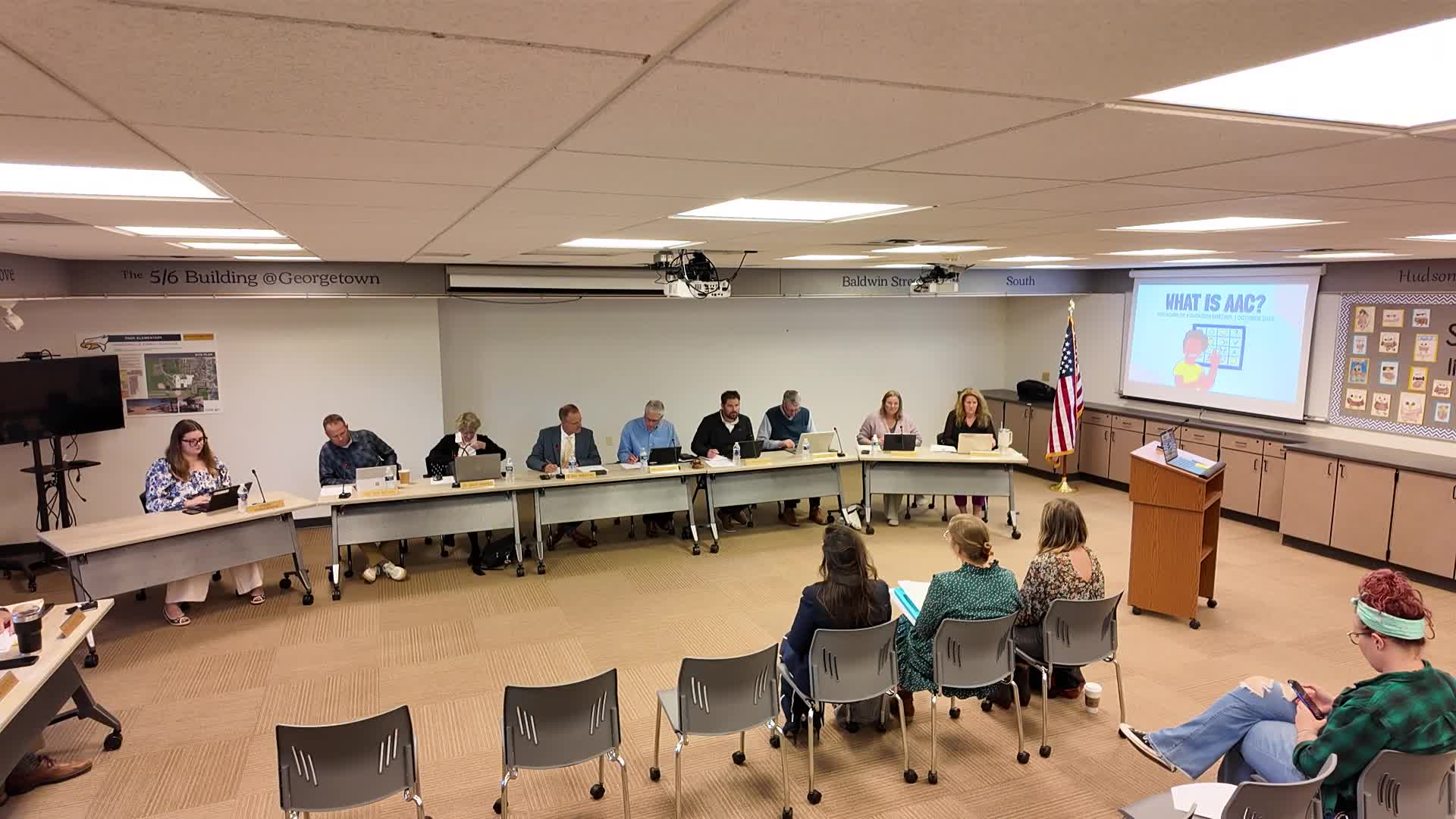Hudsonville schools highlight AAC tools as classroom supports for students with complex communication needs
October 27, 2025 | Hudsonville Public School District, School Boards, Michigan
This article was created by AI summarizing key points discussed. AI makes mistakes, so for full details and context, please refer to the video of the full meeting. Please report any errors so we can fix them. Report an error »

Hudsonville Public School District special-education staff gave the board a demonstration of augmentative and alternative communication, or AAC, describing how the tools help students who cannot rely on speech alone to express needs, wants and ideas. Melissa Clark, a speech-language pathologist, and Jenna Vanderplugh, a teacher who supports the district�s cognitive-impairment program at PARC, outlined no-tech, low-tech, mid-tech and high-tech options and gave examples of classroom use.
"AAC is augmentative or alternative communication," Beth, a district special-education presenter, said. She explained AAC can range from gestures and sign (no-tech) and visual schedules or core boards (low-tech) to single-message mid-tech buttons and high-tech apps on iPads that provide voice output and allow users to build sentences.
Clark and Vanderplugh described how teams evaluate students� needs through the SET process (student, environment, task, technology) and make IEP-based decisions about introducing devices. Clark said many AAC users are served in categorical programs for autism spectrum disorder and intellectual disability and at the early-childhood level, though students with motor-speech disorders or degenerative conditions also use AAC.
The presenters gave concrete district counts: "We have about 40 students out there who are using a 1-to-1 device," Beth said, and the district maintains roughly 70 additional iPads with AAC apps for classroom/shared use or modeling. Staff stressed that successful use requires adult modeling and training: when a student gets a high-tech device, the district conducts parent training, signs a tech release with the technology department, and the device may go home while the student remains enrolled.
Vanderplugh showed a classroom video of a student, identified in the presentation as Cardo, using a talker app (the presenters mentioned the LAMP app/license as one commonly used). The presenters said a mid-tech button replaced a problematic behavior for another student by giving a reliable way to request a walk, and they described students who have moved from AAC toward greater verbal speech over time.
On licensing and costs, Clark said some apps require subscriptions while others (she cited LAMP) are one-time purchases and that the district�s licenses can be transferred to replacement devices; that, she said, reduces the long-term risk if an iPad fails or is damaged.
District staff emphasized the supports are individualized and iterative: "It's a whole process. It takes a little time, so it's like a journey," Beth said, describing the IEP-team decision-making and the need for adult modeling in classrooms. Board members asked clarifying questions about eligibility and long-term access; presenters repeatedly noted decisions are IEP-driven and that training for parents and classroom teams is part of deployment.
The presentation concluded with administrators noting widespread low-tech supports already embedded in early-childhood classrooms (core boards and posters on playgrounds) and the district�s commitment to training to expand effective use across grade levels.
"AAC is augmentative or alternative communication," Beth, a district special-education presenter, said. She explained AAC can range from gestures and sign (no-tech) and visual schedules or core boards (low-tech) to single-message mid-tech buttons and high-tech apps on iPads that provide voice output and allow users to build sentences.
Clark and Vanderplugh described how teams evaluate students� needs through the SET process (student, environment, task, technology) and make IEP-based decisions about introducing devices. Clark said many AAC users are served in categorical programs for autism spectrum disorder and intellectual disability and at the early-childhood level, though students with motor-speech disorders or degenerative conditions also use AAC.
The presenters gave concrete district counts: "We have about 40 students out there who are using a 1-to-1 device," Beth said, and the district maintains roughly 70 additional iPads with AAC apps for classroom/shared use or modeling. Staff stressed that successful use requires adult modeling and training: when a student gets a high-tech device, the district conducts parent training, signs a tech release with the technology department, and the device may go home while the student remains enrolled.
Vanderplugh showed a classroom video of a student, identified in the presentation as Cardo, using a talker app (the presenters mentioned the LAMP app/license as one commonly used). The presenters said a mid-tech button replaced a problematic behavior for another student by giving a reliable way to request a walk, and they described students who have moved from AAC toward greater verbal speech over time.
On licensing and costs, Clark said some apps require subscriptions while others (she cited LAMP) are one-time purchases and that the district�s licenses can be transferred to replacement devices; that, she said, reduces the long-term risk if an iPad fails or is damaged.
District staff emphasized the supports are individualized and iterative: "It's a whole process. It takes a little time, so it's like a journey," Beth said, describing the IEP-team decision-making and the need for adult modeling in classrooms. Board members asked clarifying questions about eligibility and long-term access; presenters repeatedly noted decisions are IEP-driven and that training for parents and classroom teams is part of deployment.
The presentation concluded with administrators noting widespread low-tech supports already embedded in early-childhood classrooms (core boards and posters on playgrounds) and the district�s commitment to training to expand effective use across grade levels.
Don't Miss a Word: See the Full Meeting!
Go beyond summaries. Unlock every video, transcript, and key insight with a Founder Membership.
✓
Get instant access to full meeting videos
✓
Search and clip any phrase from complete transcripts
✓
Receive AI-powered summaries & custom alerts
✓
Enjoy lifetime, unrestricted access to government data
30-day money-back guarantee

